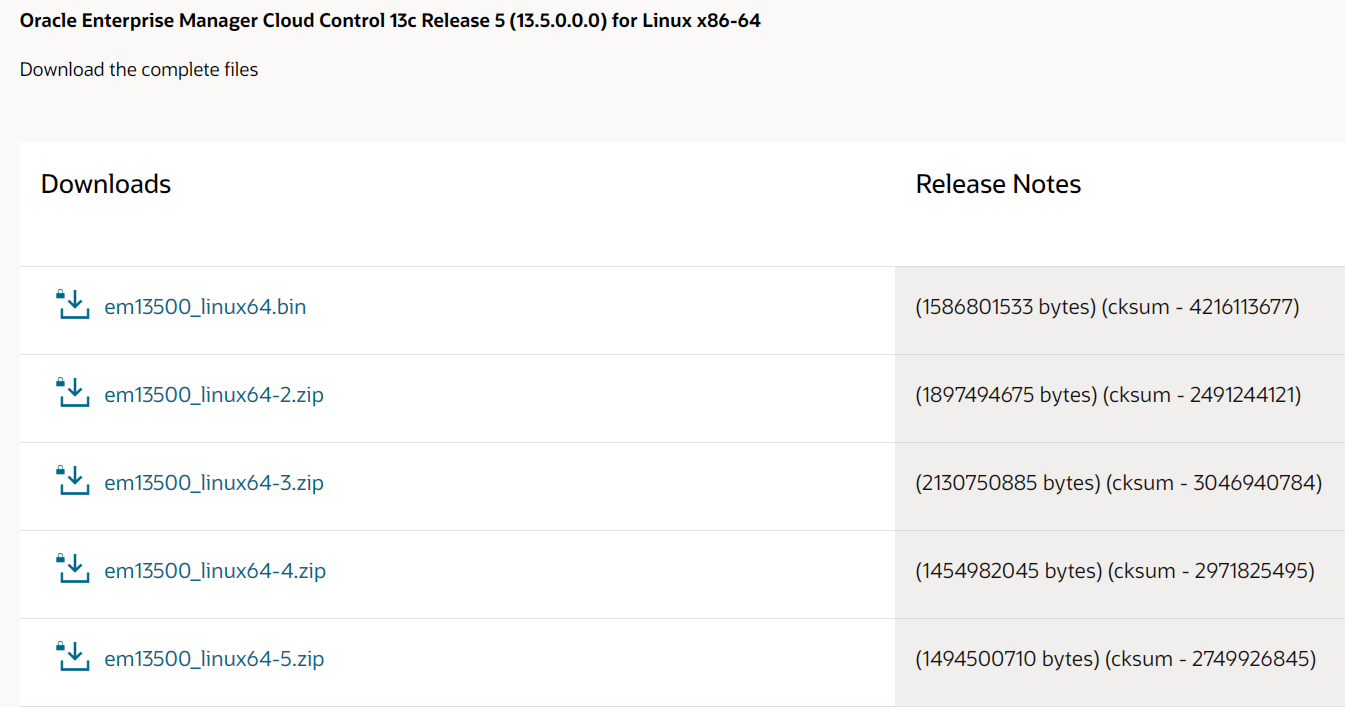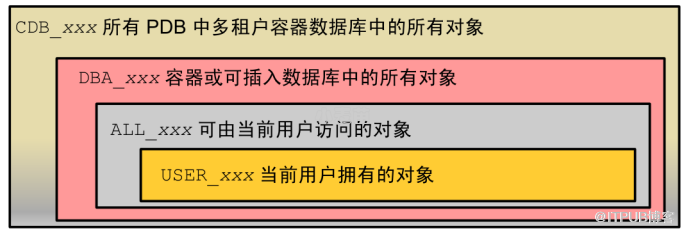合 Oracle EMCC 13.5安装过程
下载EMCC软件
https://www.oracle.com/enterprise-manager/downloads/cloud-control-downloads.html
https://www.oracle.com/enterprise-manager/downloads/linux-x86-64-13c-rel5-downloads.html
Directions
- Download all the files including .bin in same directory. No need to unzip the downloaded software.
- As the install user who will be installing the product, set the execute permission for the .bin file. Example: chmod +x em13500_linux64.bin
- Installation guides and general Enterprise Manager documentation can be found here.
1 2 3 4 5 6 7 8 9 | [root@docker35 soft]# ll total 8363828 -rw-r--r-- 1 root root 1897494675 May 17 14:42 em13500_linux64-2.zip -rw-r--r-- 1 root root 2130750885 May 17 14:43 em13500_linux64-3.zip -rw-r--r-- 1 root root 1454982045 May 17 14:42 em13500_linux64-4.zip -rw-r--r-- 1 root root 1494500710 May 17 14:42 em13500_linux64-5.zip -rw-r--r-- 1 root root 1586801533 May 17 14:40 em13500_linux64.bin [root@docker35 soft]# du -sh . 8.0G . |
安装的产品
As part of a new Enterprise Manager system, the installation wizard does the following:
Installs Oracle WebLogic Server 12c Release 2 (12.2.1.4.0).
Installs Java Development Kit (JDK) 1.8.0_261.
Installs Oracle Management Service 13c Release 5.
Installs Oracle Management Agent 13c Release 5 in the agent base directory you specify (outside the middleware home).
Installs Oracle JRF 12c Release 2 (12.2.1.4.0).
Installs Oracle Web Tier 12c Release 2 (12.2.1.4.0).
Creates a plug-in directory and installs the following default plug-ins.
Oracle Database Plug-in
Oracle Fusion Middleware Plug-in
Note:
Starting with 13c Release 1, as part of the Oracle Fusion Middleware Plug-in deployment, one Java Virtual Machine Diagnostics (JVMD) Engine is installed by default on the OMS. For every additional OMS you deploy, you receive one JVMD Engine by default with that OMS.
JVMD enables administrators to diagnose performance problems in Java applications in the production environment. By eliminating the need to reproduce problems, it reduces the time required to resolve these problems, thus improving application availability and performance.
While JVMD Engine is installed by default on the OMS host, you will still need JVMD Agents to be manually deployed on the targeted JVMs. For instructions to deploy the JVMD Agent, see Installing JVM Diagnostic Agents.
Oracle Exadata Plug-in
Oracle Cloud Framework Plug-in
Oracle System Infrastructure Plug-in
Any other additional plug-ins you choose to deploy
Creates an Oracle WebLogic domain called
GCDomain.For this WebLogic Domain, a default user account,weblogic, is used as the administrative user. In advanced installation, you can choose to change this if you want.Creates a Node Manager user account called
nodemanager.A Node Manager enables you to start, shut down, or restart an Oracle WebLogic Server instance remotely, and is recommended for applications with high availability requirements.Note:
On Microsoft Windows, a Node Manager service is NOT created. This is an expected behavior.
Configures an Oracle Management Service Instance Base location (
gc_inst) outside the Oracle Middleware home (Middleware home), for storing all configuration details related to the OMS. In advanced installation, you can choose to change this location if you want.For example, if the Middleware home is
/u01/software/em13c/oraclehome,then the instance base location is/u01/software/em13c/gc_inst.You can choose to change this, if you want, in the installer. However, you can change it for only advanced installation and not for simple installation.Configures Oracle Management Repository in the existing, certified Oracle Database. If the database instance is created using the database template offered by Oracle, then this step is skipped.
Note:
The existing, certified Oracle Database must be one of the certified databases listed in the Enterprise Manager certification matrix available on My Oracle Support, or a database instance created with a preconfigured Oracle Management Repository (Management Repository) using the database templates offered by Oracle.
To access the Enterprise Manager certification matrix, follow the steps outlined in Accessing the Enterprise Manager Certification Matrix.
For information about creating a database instance with a preconfigured Management Repository using the database templates offered by Oracle, refer to Creating a Database Instance with Preconfigured Repository Using Database Templates.
The database can be on a local or remote host, and if it is on a remote host, it must be monitored by Oracle Management Agent. However, Oracle Real Application Clusters (Oracle RAC) databases must only be on a shared disk.
Runs the following configuration assistants to configure the installed components for simple as well as advanced installation:
Plug-ins Prerequisites Check
Repository Configuration
Note:
If you use a database instance that was created with a preconfigured Management Repository using the database templates offered by Oracle, then Repository Out-of-Box Configuration is run instead of Repository Configuration.
- MDS Schema Configuration
Note:
If you use a database instance that was created with a preconfigured Management Repository using the database templates offered by Oracle, then MDS Schema Configuration is not run.
OMS Configuration
Plug-ins Deployment and Configuration
Start Oracle Management Service
Agent Configuration Assistant
兼容性:
Oracle Management Service 13c Release 5 can communicate only with the following Oracle Management Agents versions you may have deployed from earlier Enterprise Manager Cloud Control versions: 13.4.0.0.0 and 13.3.0.0.0.
Table 5-2 Compatibility Between OMS and Management Agents Across 13c and 12c Releases
| - | Oracle Management Agent 12c Release 5 (12.1.0.5) | Oracle Management Agent 13c Release 1 | Oracle Management Agent 13c Release 2 | Oracle Management Agent 13c Release 3 | Oracle Management Agent 13c Release 4 |
|---|---|---|---|---|---|
| Oracle Management Service 13c Release 5 | No | No | No | Yes | Yes |
系统条件
端口
The following are the default ports used for installation:
Enterprise Manager Cloud Control
Table 2-2 Default Port for Enterprise Manager Grid Control
- Upload Port Console Port HTTP Port The first available free port from the range 4889 to 4898 is selected. The first available free port from the range 7788 - 7798 is selected. HTTPS Port 1159If 1159 is not available, then the first available free port from the range 4899 to 4908 is selected. The first available free port from the range 7799 - 7809 is selected. Oracle Management Agent
The default upload port for Management Agent is 3872. The same port is used for both HTTP and HTTPS. If 3872 is not available, then the first available free port from the range 1830 to 1849 is selected.
Administration Server
The default HTTPS port for Admin Server is 7101. If 7101 is not available, then the first available free port from the range 7101 to 7200 is selected.
Node Manager
The default HTTPS port is the first available free port from the range 7401 to 7500 is selected.
Managed Server
The default HTTP port is the first available free port from the range 7201 to 7300 is selected.
The default HTTPS port is the first available free port from the range 7301 to 7400 is selected.
JVM Diagnostics Managed Server
If SLB is not configured, then the aforementioned HTTP and HTTPS upload ports of Enterprise Manager Cloud Control are used. If SLB is configured, then the ports configured for JVM Diagnostics on the SLB are used. Alternatively, in addition to the SLB configuration, if the HTTP upload port is enabled for Enterprise Manager Cloud Control, then the HTTP upload port also can be used by the JVM Diagnostics Agents for communicating with the JVM Diagnostics Engine.
Oracle HTTP Server
The default HTTP port for Oracle HTTP Server is 9788. If 9788 is not available, then the first available free port from the range 9751 to 9800 is selected.
本人提供Oracle(OCP、OCM)、MySQL(OCP)、PostgreSQL(PGCA、PGCE、PGCM)等数据库的培训和考证业务,私聊QQ646634621或微信dbaup66,谢谢!






